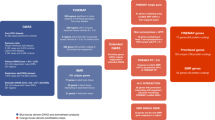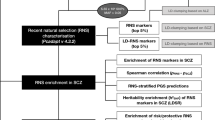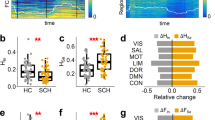Abstract
Schizophrenia is a complex psychiatric disorder with both genetic and environmental components and is thought to be in part neurodevelopmental in origin. The DISC1 gene has been linked to schizophrenia in two independent Caucasian populations. The DISC1 protein interacts with a variety of proteins including FEZ1, the mammalian homolog of the Caenorhabditis elegans unc-76 protein, which is involved in axonal outgrowth. Variation at the FEZ1 gene has been associated with schizophrenia in a large Japanese cohort. In this study, nine SNP markers at the FEZ1 locus were genotyped in two populations. A North American Caucasian cohort of 212 healthy controls, 178 schizophrenics, 79 bipolar disorder, and 58 with schizoaffective disorder, and an African American cohort of 133 healthy controls, 162 schizophrenics, and 28 with schizoaffective disorder. No association to schizophrenia, bipolar disorder or schizoaffective disorder was found for any of the nine markers typed in these populations at the allelic or the genotypic level. Additionally no association was found in either population between specific haplotypes and any of the psychiatric disorders. Variation at the FEZ1 locus does not play a significant role in the etiology of schizophrenia, bipolar disorder or schizoaffective disorder in North American Caucasian or African American populations.
Similar content being viewed by others
Log in or create a free account to read this content
Gain free access to this article, as well as selected content from this journal and more on nature.com
or
References
Austin CP, Ky B, Ma L, Morris JA, Shughrue PJ (2004). Expression of disrupted-in-Schizophrenia-1, a schizophrenia-associated gene, is prominent in the mouse hippocampus throughout brain development. Neuroscience 124: 3–10.
Barbato A (1998). Schizophrenia and Public Health. http://www.who.int/mental_health/media/en/55.pdf.
Barrett JC, Fry B, Maller J, Daly MJ (2005). Haploview: analysis and visualization of LD and haplotype maps. Bioinformatics 21: 263–265.
Berry N, Jobanputra V, Pal H (2003). Molecular genetics of schizophrenia: a critical review. J Psychiatry Neurosci 28: 415–429.
Blackwood DH, Fordyce A, Walker MT, St Clair DM, Porteous DJ, Muir WJ (2001). Schizophrenia and affective disorders—cosegregation with a translocation at chromosome1q42 that directly disrupts brain-expressed genes: clinical and P300 findings in a family. Am J Hum Genet 69: 428–433.
Brandon NJ, Handford EJ, Schurov I, Rain JC, Pelling M, Duran-Jimeniz B . et al (2004). Disrupted in Schizophrenia 1 and Nudel form a neurodevelopmentally regulated protein complex: implications for schizophrenia and other major neurological disorders. Mol Cell Neurosci 25: 42–45.
Cordell HG (2002). Epistasis: what it means, what it doesn't mean, and statistical methods to detect it in humans. Hum Mol Genet 11: 2463–2468.
Devon RS, Anderson S, Teague PW, Burgess P, Kipari TM, Semple CA et al (2001). Identification of polymorphisms within disrupted in Schizophrenia 1 and disrupted in Schizophrenia 2, and an investigation of their association with schizophrenia and bipolar affective disorder. Psychiatr Genet 11: 71–78.
Feinberg I (1982). Schizophrenia: caused by a fault in programmed synaptic elimination during adolescence? J Psychiatr Res 17: 319–334.
Gabriel SB, Schaffner SF, Nguyen H, Moore JM, Roy J, Blumenstiel B et al (2002). The structure of haplotype blocks in the human genome. Science 296: 2225–2229.
Hennah W, Varilo T, Kestilä M, Paunio T, Arajärvi R, Haukka J et al (2003). Haplotype transmission analysis provides evidence of association for DISC1 to schizophrenia and suggests sex-dependent effects. Hum Mol Genet 12: 3151–3159.
Hodgkinson CA, Goldman D, Jaeger J, Persaud S, Kane JM, Lipsky RH et al (2004). Disrupted in schizophrenia 1 (DISC1): association with schizophrenia, schizoaffective disorder, and bipolar disorder. Am J Hum Genet 75: 862–872.
Honda A, Miyoshi K, Baba K, Taniguchi M, Koyama Y, Kuroda S et al (2004). Expression of fasciculation and elongation protein zeta-1 (FEZ1) in the developing rat brain. Brain Res Mol Brain Res 122: 89–92.
Horvitz HR (1997). The Caenorhabditis elegans gene unc-76 and its human homolgos define a new family involved in axonal outgrowth and fasciculation. Proc Nat Acad Sci USA 94: 3414–3419.
Hwu HG, Liu CM, Fann CS, Ou-Yang WC, Lee SF (2003). Linkage of schizophrenia with chromosome 1q loci in Taiwanese families. Mol Psychiatry 8: 445–452.
Inoue K, Terashima T, Nishikawa T, Takumi T (2004). Fez1 is layer-specifically expressed in the adult mouse neocortex. Eur J Neurosci 20: 2909–2916.
James R, Adams RR, Christie S, Buchanan SR, Porteous DJ, Millar JK (2004). Disrupted in Schizophrenia 1 (DISC1) is a multicompartmentalized protein that predominantly localizes to mitochondria. Mol Cell Neurosci 26: 112–122.
Kockelkorn TT, Arai M, Matsumoto H, Fukuda N, Yamada K, Minabe Y et al (2004). Association study of polymorphisms in the 5′ upstream region of human DISC1 gene with schizophrenia. Neurosci Lett 368: 41–45.
Lewis DA, Levitt P (2002). Schizophrenia as a disorder of neurodevelopment. Annu Rev Neurosci 25: 409–432.
Marenco S, Weinberger DR (2000). The neurodevelopmental hypothesis of schizophrenia: following a trail of evidence from cradle to grave. Dev Psychopathol 12: 501–527.
Millar JK, Christie S, Anderson S, Lawson D, Hsiao-Wei Loh D, Devon RS et al (2001). Genomic structure and localisation within a linkage hotspot of Disrupted In Schizophrenia 1, a gene disrupted by a translocation segregating with schizophrenia. Mol Psychiatry 6: 173–178.
Millar JK, Christie S, Porteous DJ (2003). Yeast two-hybrid screens implicate DISC1 in brain development and function. Biochem Biophys Res Commun 311: 1019–1025.
Millar JK, Wilson-Annan JC, Anderson S, Christie S, Taylor MS, Semple CA et al (2000). Disruption of two novel genes by a translocation co-segregating with schizophrenia. Hum Mol Genet 9: 1415–1423.
Miyoshi K, Asanuma M, Miyazaki I, Diaz-Corrales FJ, Katayama T, Tohyama M et al (2004). DISC1 localizes to the centrosome by binding to kendrin. Biochem Biophysl Res Commun 317: 1195–1199.
Miyoshi K, Honda A, Baba K, Taniguchi M, Oono K, Fujita T et al (2003). Disrupted-In-Schizophrenia 1, a candidate gene for schizophrenia, participates in neurite outgrowth. Mol Psychiatry 8: 685–694.
Morris JA, Kandpal G, Ma L, Austin CP (2003). DISC1 (Disrupted-In-Schizophrenia 1) is a centrosome-associated protein that interacts with MAP1A, MIPT3, ATF4/5 and NUDEL: regulation and loss of interaction with mutation. Hum Mol Genet 12: 1591–1608.
Norton N, Moskvina V, Morris DW, Bray NJ, Zammit S, Williams NM et al (2006). Evidence that interaction between neuregulin 1 and its receptor erbB4 increases susceptibility to schizophrenia. Am J Med Genet B Neuropsychiatr Genet 141: 96–101.
Ozeki Y, Tomoda T, Kleiderlein J, Kamiya A, Bord L, Fujii K et al (2003). Disrupted-in-Schizophrenia-1 (DISC-1): mutant truncation prevents binding to NudE-like (NUDEL) and inhibits neurite outgrowth. Proc Natl Acad Sci USA 100: 289–294.
Schurov IL, Handford EJ, Brandon NJ, Whiting PJ (2004). Expression of disrupted in schizophrenia 1 (DISC1) protein in the adult and developing mouse brain indicates its role in neurodevelopment. Mol Psychiatry 9: 1100–1110.
Shirts BH, Nimgaonkar V (2004). The genes for schizophrenia: finally a breakthrough? Curr Psychiatry Rep 6: 303–312.
Stefansson H, Steinthorsdottir V, Thorgeirsson TE, Gulcher JR, Stefansson K (2004). Neuregulin 1 and schizophrenia. Ann Med 36: 62–71.
Stephens M, Donnelly P (2003). A comparison of Bayesian methods for haplotype reconstruction from population genotype data. Am J Hum Genet 73: 1162–1169.
Stephens M, Smith N, Donnelly P (2001). A new statistical method for haplotype reconstruction from population data. Am J Hum Genet 68: 978–989.
Yamada K, Nakamura K, Minabe Y, Iwayama-Shigeno Y, Takao H, Toyota T et al (2004). Association analysis of FEZ1 variants with schizophrenia in Japanese cohorts. Biol Psychiatry 56: 683–690.
Acknowledgements
This project was supported by grants from the National Institutes of Mental Health (K23MH001760), NARSAD, and the Stanley Medical Research Institute to AKM and support from the National Institute on Alcohol Abuse and Alcoholism Intramural Research Program. The authors also wish to acknowledge the effort of all of the patients and staff at the Zucker Hillside Hospital and the Psychiatry Service, Department of Veterans Affairs, New Jersey Health System who participated in this study.
Author information
Authors and Affiliations
Corresponding author
Rights and permissions
About this article
Cite this article
Hodgkinson, C., Goldman, D., Ducci, F. et al. The FEZ1 Gene Shows No Association to Schizophrenia in Caucasian or African American Populations. Neuropsychopharmacol 32, 190–196 (2007). https://doi.org/10.1038/sj.npp.1301177
Received:
Revised:
Accepted:
Published:
Issue date:
DOI: https://doi.org/10.1038/sj.npp.1301177
Keywords
This article is cited by
-
PKNOX2 is Associated with Formal Thought Disorder in Schizophrenia: a Meta-Analysis of Two Genome-wide Association Studies
Journal of Molecular Neuroscience (2012)
-
Impact of race on efficacy and safety during treatment with olanzapine in schizophrenia, schizophreniform or schizoaffective disorder
BMC Psychiatry (2010)
-
Evidence of statistical epistasis between DISC1, CIT and NDEL1 impacting risk for schizophrenia: biological validation with functional neuroimaging
Human Genetics (2010)
-
The DISC locus in psychiatric illness
Molecular Psychiatry (2008)



